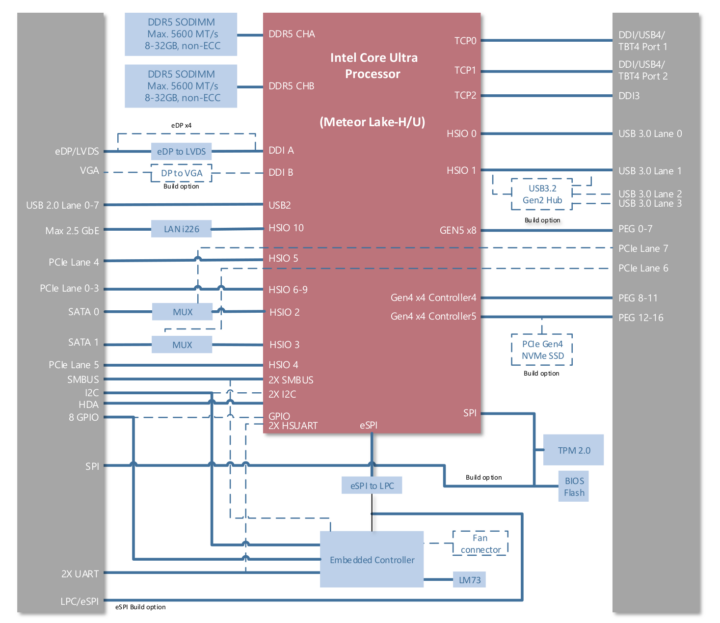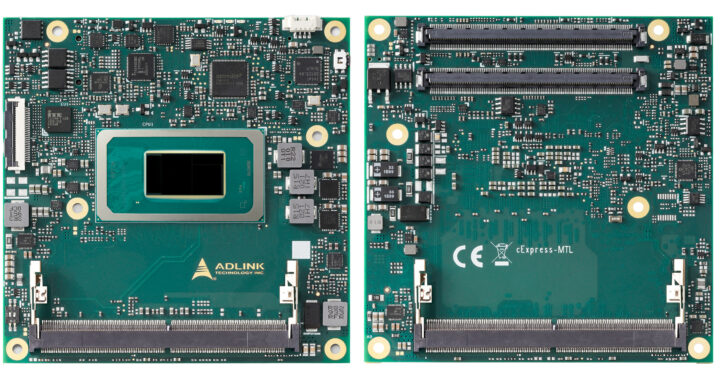ADLINK cExpress-MTL is a COM Express Type 6 Compact module based on the just-announced 14th gen Intel Core Ultra “Meteor Lake” processor family with up to fourteen CPU cores in 6P+8E configuration, eight Xe-cores (128 EUs), and an NPU (11pTOPS/8.2eTOPS) in a 15 or 28W TDP thermal configuration delivering up to 1.9x the GPU performance of the previous generation (Raptor Lake).
The power consumption will also be lower thanks to Intel Core Ultra’s new Low-Power E-cores that are 30 to 50% more efficient than the E-cores in 13th gen Intel Core processors, and the faster GPU and built-in NPU will enable hardware-accelerated AV1 encoding/decoding and various devices leveraging AI such as portable medical ultrasound devices, industrial automation, autonomous driving, AI robots, and more.
cExpress-MTL specifications:
- Meteor Lake-H/U SoC (one of the other)
- Intel Core Ultra 7 MS3 165H 16-core (6P+8E+2LPE) processor @ 1.4 / 5.0 GHz with 24MB cache, Intel 8Xe LPG graphics @ 2.3 GHz, Intel AI Boost NPU; TDP: 28W
- Intel Core Ultra 7 T4 155H 16-core (6P+8E+2LPE) processor @ 1.4 / 4.8 GHz with 24MB cache, Intel 8Xe LPG graphics @ 2.25 GHz, Intel AI Boost NPU; TDP: 28W
- Intel Core Ultra 5 MS1 135H 14-core (4P+8E+2LPE) processor @ 1.7 / 4.6 GHz with 18MB cache, Intel 8Xe LPG graphics @ 2.2 GHz, Intel AI Boost NPU; TDP: 28W
- Intel Core Ultra 5 T3 125H 14-core (4P+8E+2LPE) processor @ 1.2 / 4.9 GHz with 18MB cache, Intel 7Xe LPG graphics @ 2.2 GHz, Intel AI Boost NPU; TDP: 28W
- Intel Core Ultra 7 MS3 165U 12-core (2P+8E+2LPE) processor @ 1.7 / 4.9 GHz with 12MB cache, Intel 4Xe LPG graphics @ 2.0 GHz, Intel AI Boost NPU; TDP: 15W
- Intel Core Ultra 7 T4 155U 12-core (2P+8E+2LPE) processor @ 1.7 / 4.8 with 12MB cache, Intel 4Xe LPG graphics @ 1.95 GHz, Intel AI Boost NPU; TDP: 15W
- Intel Core Ultra 5 MS1 135U 12-core (2P+8E+2LPE) processor @ 1.6 / 4.4 GHz with 12MB cache, Intel 4Xe LPG graphics @ 1.9 GHz, Intel AI Boost NPU; TDP: 15W
- Intel Core Ultra 5 T3 125U 12-core (2P+8E+2LPE) processor @ 1.3 / 4.3 GHz with 12MB cache, Intel 4Xe LPG graphics @ 1.85 GHz, Intel AI Boost NPU; TDP: 15W
- GPU features: AV1 encode/decode, H.265 (HEVC) 8-bit codec, DX 12.1, OpenGL 4.6, oneAPI
- System Memory – Up to 64GB (2x 32GB) DDR5 in-band ECC/non-ECC SO-DIMM memory, max. 5600MT/s
- Storage
- 2x SATA 6Gb/s ports
- Optional NVMe SSD storage (BGA) in place of PEG lanes 12-16 (build option)
- Optional eMMC 5.1 flash
- 16MB or 32MB flash for AMI UEFI/BIOS with Intel AMT 12.x support
- Display Interfaces
- 3x DDI supporting DisplayPort 1.4a, HDMI 2.0b, and VGA (build option)
- 1x LVDS (optional eDP 1.4b)
- Up to 2x USB4/TBT4 in place of DDI 1/2 (Thunderbolt 4 requires BIOS update, by project basis)
- Up to 4x independent displays
- Audio – Integrated chipset on SoC, ALC888 audio codec on carrier board such as Express-BASE6
- Ethernet
- Intel i226 series controllers (I226-IT/V supports TSN by build option)
- 2.5GbE and Gigabit Ethernet
- USB – 2x USB 3.2/2.0/1.1, 1x USB 3.2 (BoM option), 6x USB 2.0, up to 2x USB4 interfaces (Thunderbolt 4 capable, build option)
- Expansion Busses
- Up to 8x PCIe x1 Gen4 lanes (AB) – Lanes 0/1/2/3 and Lanes 4/5/6/7 (configurable to 4 x1, 2 x2, 1 x4, 2 x1 + 1 x2, 1 x2 + 2 x1, lanes 6/7 by option)
- I2C, SMBus management buses
- 2x UART ports with console redirection
- 8x GPIO (GPI with interrupt)
- SEMA Board Controller – Voltage/current monitoring, power sequence debug support, AT/ATX mode control, logistics and forensic information, general purpose I2C, UART, GPIO, watchdog timer, fan control
- Super I/O – Supported on carrier if needed (standard support for W83627DHG-P, other Super I/O supported by project basis)
- Debugging – 30-pin multipurpose flat cable connector for use with DB30-x86 debug module
- Security – Infineon TPM 2.0 SPI device
- Power Management
- Input – 12V; AT/ATX support
- ACPI 5.0 compliant, Smart Battery support
- Power States – C1-C6, S0, S1, S2, S3,S4, S5, S5 ECO mode (Wake on USB S3/S4, WoL S3/S4/S5)
- ECO modes – Supports deep S5 mode for power savings
- Dimensions – 95 x 95 mm (PICMG COM.0: Rev 3.1 Type 6 compact size)
- Temperature Range – Standard: 0°C to 60°C; Extreme Rugged: -40°C to 85°C (TBD)
- Humidity
- Operating – 5-90% RH operating, non-condensing
- Storage – 5-95% RH storage (and operating with conformal coating)
- Shock and Vibration
- IEC 60068-2-64 and IEC-60068-2-27
- MIL-STD-202F, Method 213B, Table 213-I, Condition A and Method 214A, Table 214-I, Condition D (TBC)
- HALT – Thermal Stress, Vibration Stress, Thermal Shock, and Combined Test

ADLINK provides for Windows 10 Enterprise LTSC 2021 and Yocto Linux 64-bit for the module and VxWorks 64-bit and/or Ubuntu may also be supported in the future. The company is also working on I-Pi development kits based on the cExpress-MTL module for prototyping and referencing that should be similar to the COM Express Type 6 Raptor Lake-P devkit launched in October but with the new cExpress-MTL Intel Core Ultra module.
ADLINK cExpress-MTL module does not seem to be available just yet as the information on the product page is shown as being “preliminary”. A few more details may also be found in the press release.

Jean-Luc started CNX Software in 2010 as a part-time endeavor, before quitting his job as a software engineering manager, and starting to write daily news, and reviews full time later in 2011.
Support CNX Software! Donate via cryptocurrencies, become a Patron on Patreon, or purchase goods on Amazon or Aliexpress






Congatec has announced its own Intel Core Ultra Meteor Lake “conga-TC700” COM Express Compact module:
https://www.congatec.com/en/congatec/press-releases/article/congatec-launches-com-express-compact-module-with-brand-new-intelr-coretm-ultra-processors/
> The power consumption will also be lower thanks to Intel Core Ultra’s new Low-Power E-cores that are 30 to 50% more efficient
I thought the (idle / low load) power savings are more related to these two cores being part of the ‘SoC tile’ so that the whole ‘compute tile’ containing P and ‘big’ E cores can be powered off under low load conditions?
ADLINK listed the Intel Core Ultra 7 MS3 165H as a 14-core (6P+8E) processor, but when I went to Ark Intel that’s a 16-core processor with the two extra Low-Power E-Cores. I’m not sure how this all works. We will find out soon enough as Meteor Lake mini PCs will be announced at CES 2023 and we will probably get one for review.
I believe they are clocked even lower than regular E-cores, maybe with other tricks to reduce power consumption. But they are on an older TSMC N6 node. Beats me how they could be “30 to 50% more efficient” than E-cores at the same clock speed. I wonder how often the compute tile could even be “powered off” during real world use, i.e. not the laptop sitting around unattended with the screen turned off but not in sleep mode. If you have a news site open and don’t use an adblocker, I bet the compute tile will never turn off. These… Read more »
> I believe they are clocked even lower than regular E-cores
Sure, all the Meteor Lake SKUs that are listed since two days claim to clock the LPE cores at up to 2.5 GHz while the normal E cores ‘boost’ between 3.5 and 3.8 GHz.